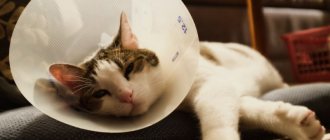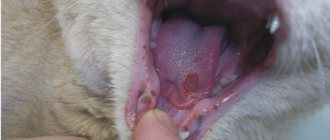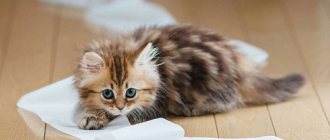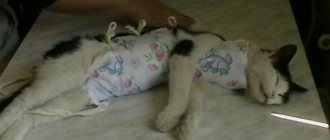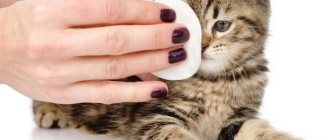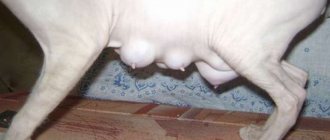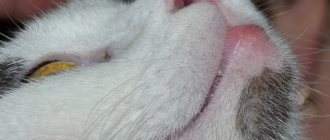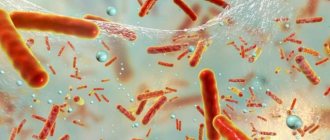Causes of complications after castration:
Sterilization is the artificial deprivation of reproductive abilities by removing the testes. In veterinary medicine, surgery is well mastered, but like any intervention it requires proper preliminary preparation and proper postoperative care.
The main reasons for the negative consequences:
- the procedure is performed by a low-qualified veterinarian;
- failure to comply with sanitary standards during surgery;
- insufficient hygiene of the castration wound;
- the presence of diseases of the genitourinary system.
After sterilization, serious changes occur in the four-legged body. A veterinary examination should be carried out regularly.
Inflammation of the spermatic cord stump
Funiculitis occurs for several reasons:
- contamination of the spermatic cord;
- when the stump falls out of the seam;
- excessively large crush area (with bloodless castration);
- tightening the ligature on the area of the vascular cone;
- coarse threads;
- the area below the sutures is too long.
With an inflammatory reaction in the spermatic cord, a response of granulation tissue in the form of inadequate proliferation is possible. The overgrown granulation tissue forms a granuloma, which is saturated with fibrin. Because of this, the granuloma becomes an irritant of the inflammatory process, as a result the circle closes, the inflammation becomes self-sustaining. As a result, due to random division, granulocytes degenerate into a tumor.
Even if the complication is limited only to ordinary inflammation, without degeneration into a granuloma, it is still very dangerous. Since the inflammatory purulent process can spread along the spermatic cord into the abdominal cavity. As a result, peritonitis and sepsis occur, which can even lead to the death of the pet.
Complications in cats after castration: types, symptoms, treatment
The procedure is performed under general anesthesia, the animal does not feel anything. After castration, the cat needs special care. Compliance with all before and after operating procedures minimizes the likelihood of unpleasant consequences, but does not completely eliminate them.
Complications are divided into two groups: late and early.
The latter are observed more often and include:
- painful sensations;
- digestive disorders;
- bleeding;
- self-injury, for prevention, wear a protective collar for several days;
- inflammation, suppuration, abscess;
- prolapse of parts of the internal genital organs or intestinal loop;
- wound infection.
In the normal course of events, the pain goes away after 1-2 days. Your doctor may prescribe pain medications. Digestion is restored within a week, provided you follow the diet recommended by your veterinarian. For other manifestations, the animal is taken to a veterinary clinic.
Be sure to read:
Do-it-yourself cat blanket: what is it for, what to use, what to make, step-by-step instructions on how to tie
Late complications do not appear immediately:
- problems with urination as a result of injury to the ureter;
- formation of fistulas (when using the ligature method of sterilization);
- weakening of the urethral sphincter due to hormonal changes;
- urolithiasis disease.
To avoid late severe consequences, veterinary examinations are carried out regularly.
Pain reaction after surgery
Painful sensations are the most common type of complications. Removal of the gonads is a painful procedure performed under anesthesia. After leaving the anesthesia (2-24 hours), the predator marks the territory, urination is involuntary. Urine getting on the wound causes burning and pain.
An inflammatory process accompanied by unpleasant sensations is inevitable. Pets are trying to “lick” the wound. To avoid germs and additional trauma, a special collar is worn on the neck for 3-4 days.
With severe pain, behavior becomes aggressive. To alleviate the condition, the veterinarian prescribes pain medication. If the situation worsens, the pet is taken to the doctor.
Bleeding
Liquid discharge and ichor in small quantities are normal after surgery. A trickle of blood flowing from the wound should alert you. Bleeding can also be internal; the main symptom is a swollen abdomen.
Causes:
- insufficient compression of the skin during surgery;
- hypocoagulation;
- phlebeurysm;
- incorrect ligature application;
- the biological knot is loosely tied;
- seam divergence;
- vascular sclerosis;
- improper care after sterilization.
In case of bleeding from the vessels of the scrotum, artery of the vas deferens, or the stump of the spermatic cord, repeated intervention is necessary. After identifying the source of bleeding, the doctor torses or ligates the vessel.
The animal is tested for clotting. If the test reveals hypocoagulation, I prescribe therapy.
Scrotal swelling
Enlargement of the scrotum by more than 2 times, with inflammation spreading to the foreskin, peritoneum, and high temperature indicate infection in the body. Pathogenic organisms are introduced by violating the rules of antiseptics, poor pet hygiene, or lack of walks. The progression of the infectious process is facilitated by the accumulation of dead cells in the wound. The wound heals, creating favorable conditions for the formation of an abscess.
Treatment is carried out as early as possible. The doctor removes the adhesions and exudate that has accumulated in the scrotal cavity. The wound is treated with iodine solution. To avoid secondary adhesions, the affected area is treated with boron ointment. Treatment is carried out with titrated antibacterial drugs.
Be sure to read:
After sterilization, the cat does not eat or drink for several days: what to do, what to feed
Tissue loss
In case of prolapse of the omentum, spermatic cord stump, vaginal membrane, severe infectious lesion. Tissues come into contact with microbes, and the immune response is weakened. Prolapse of the intestinal loop threatens the intestines to come out.
Treatment is surgical. The prolapsed part of the vaginal membrane or spermatic cord is amputated with an emasculator, and a ligature is first applied to the cord. The omentum is pulled out, tied with thread and cut off. The intestinal loop is set back, and the tissues that come out with it are cut off.
Inflammation of the common vaginal lining
When the testicles are removed, as a result of the reduction of the external levator testis, the tunica vaginalis is pulled upward. The shell leaves are soldered together, a cavity is formed, which is filled with exudate. Under normal conditions, the exudate resolves, but when pathogens enter, inflammation develops. The process causes an acute painful reaction.
Therapy is carried out by washing the vaginal lining with hydrogen peroxide. If necessary, remove pus and adhesions. To prevent the spread of the pathological process, a course of antibiotics is prescribed.
Inflammation of the spermatic cord stump
Funiculitis begins with an increase in the cord of the inguinal canal; upon palpation, the organ is dense and motionless. The complication appears on days 4-5.
Causes:
- violation of antiseptic rules during intervention;
- incorrect ligature application;
- formation of a hematoma in the cord;
- stump loss;
- leaving large curls when unscrewing the spermatic cord.
- Treatment consists of treatment with antiseptic agents.
Retroperitoneal abscess
Treat secondary complications. Inflammation from the spermatic cord spreads through the lymph nodes to the abdominal cavity and the walls of the bladder. The process develops rapidly: the temperature rises, the cat refuses to eat, and suddenly loses weight.
After diagnosis, antibacterial or sulfonamide drugs are prescribed. If abscesses form, surgery is performed. Subsequently, the wound is washed with antiseptics.
Reasons for the appearance of a hard lump under the seam after sterilization
Any impact on the body can have various consequences. The reasons for the appearance of hard, soft swellings on the peritoneum in the area of the suture or under it are of a different nature, and not all lumps formed after sterilization pose a danger to the health of the operated cat.
As a rule, after sterilization, if the operation is performed according to all the rules, there should be no formations or compactions. A slight swelling is acceptable only on the first day after the classical sterilization method.
If you notice that after sterilization your cat has a hard swelling or lump on its abdomen, a similar phenomenon may be caused by:
- Infection in wounds. If a cat licks or chews the stitches, pathogenic microorganisms penetrate into the wounds, which provokes the development of acute inflammation. Bacteria slow down tissue regeneration and provoke other serious complications (cellulitis, abscesses, fever).
- Hernia prolapse . Occurs due to divergence of internal (subcutaneous) surgical sutures, which leads to prolapse and protrusion of internal organs into the hernial sac (peritoneal opening). A similar problem can arise due to the incompetence of the veterinarian or if low-quality suture material is used. A postoperative hernia is localized in the suture area and if there is no pinching, it does not cause pain. The seal is movable, disappears after light pressure, the lump is soft to the touch. Its size may change, for example, after eating. In the case of tissue inflammation, strangulation of the hernia may occur, which requires immediate treatment.
- Postoperative swelling. The appearance of a lump on the abdomen is the body’s protective reaction to tissue damage. After the operation, the body's defenses are activated, so a swelling forms in the area of the suture or under it. The seam swells, turns red, and the tissues look swollen. This condition is not a pathology. The swelling will go away completely within 10-17 days.
Another reason for the appearance of a hard swelling under the suture is the intensive growth of granulation tissue. Such bumps have a dense consistency, do not cause discomfort or pain and, as a rule, go away on their own after some time without any intervention. Only with deep palpation can you feel a slight compaction, which will gradually completely resolve.
A hard lump or tumor on the cat’s tummy after surgery can also occur in the event of improper care of the operated animal or inept suturing, violation of the technique of applying surgical material, if the veterinarian has low qualifications or insufficient experience.
Some medications that owners use to treat the postoperative area can cause an allergic reaction, acute inflammation, and tissue swelling.
If there is no suppuration, a very large bulge, a small bump on the abdomen may appear due to the rapid resorption of the suture material if the surgeon used self-absorbing threads. In places where the seam has not completely healed, but the thread remains, slight swelling and redness of the skin may appear.
Note that the postoperative lump is always localized in the surgical area.
Positive consequences after castration of a cat
Sterilization has a number of purposes: economic, preventive and therapeutic.
Sterilization has a number of serious advantages:
- reducing the risk of tumor development;
- immunodeficiency and leukemia viruses are rarely found in sterilized males;
- the likelihood of prostate diseases decreases;
- absence of unpleasant odor of urine in the room.
Be sure to read:
After sterilization, a cat sleeps a lot and is lethargic: normal or pathological, what consequences may occur after surgery
After removal of the gonads, testosterone production decreases. The animal becomes calmer, a balanced psyche is one of the factors influencing longevity.
Scrotal swelling
The development of edema is possible for several reasons:
- penetration of dirt into the wound, which often happens when castrating unwashed pets;
- when castrating an animal in a dirty, dusty room;
- with insufficient cleaning of the scrotal cavity, when clotted blood or severed tissue remains in it;
- tissue separation due to inaccurate movement of the scalpel;
- develops when the doctor fails to comply with antiseptic rules.
The inflammatory reaction is not observed immediately, but only a day or two after the operation. At first, the exudate is serous or serous-fibrinous, but after 3-4 days the process turns into purulent inflammation. The pathology is localized at the initial stage, but later spreads to adjacent tissues, covering the entire scrotum.
The clinical picture is quite bright:
- the scrotum becomes 1.5-2 times larger;
- the number of neutrophil leukocytes increases;
- body temperature increases by 1.5-2°C;
- at high temperatures, shortness of breath and increased heart rate are observed;
- the animal is lethargic and refuses to eat;
- serous or purulent exudate from a surgical wound.
Surgical treatment is possible , consisting of opening the abscess (if there is one) or treating the wound.
However, the main therapy is always medicinal - systemic antibiotics. To alleviate the pet’s condition, he can be given intravenous glucose 5%, calcium chloride, or novocaine.
If the cat is not castrated: consequences
Opponents of sterilization claim that there are countless uncastrated cats in the world who feel excellent and live quite a long time. Nobody takes care of stray animals; their numbers are huge.
But if they had undergone surgery to remove the gonads, they would have been able to avoid unnecessary consequences:
- Serious injuries, bites. Males during a female's heat period fight among themselves for the right to have territory and companions. They inflict severe injuries: they bite deeply, tearing the skin.
- Infectious diseases. A sexually mature animal copulates instinctively. The pet seeks to escape from the apartment in search of mating. As a result of contact with a stray “lady,” the “gentleman” becomes infected with an infectious disease.
- A predator that leaves home in search of a female is poorly adapted to street life and can get hit by a car.
- A domestic animal on the street is defenseless; it can be caught by flayers for abuse.
Having run away from the owner, the pet will not be able to return. He does not know how to get food and will die of hunger.
Bleeding
This may occur due to several factors:
- insufficient ligation of the spermatic cord stump;
- when the bandaging is too strong, when additional damage occurs;
- poor quality ligature;
- flabbiness of blood vessels, which causes them to rupture;
- low blood clotting;
- varicose veins of the spermatic vein.
Bleeding from the skin of the scrotum is not a complication . This is a normal reaction of damaged tissue. Such hemorrhage is not profuse, the blood flows drop by drop, quickly coagulates, so that it goes away half an hour after castration.
Important! A complication is bleeding from the vessels of the spermatic cord, vas deferens or scrotum.
In this case, the blood flows in a trickle, often small, but sometimes extremely powerful, it all depends on which artery or vein was damaged.
Symptoms. Bleeding can be detected by characteristic traces of blood. In severe cases, anemia, weakness, tachycardia, and the development of shock are added to the symptoms. Sometimes the bleeding becomes internal, so it is detected by pale skin, weakness, and accumulation of blood in the abdominal cavity.
Treatment is only surgical. A repeated resection is performed, the damaged vessel is found, a ligature is applied or it is sutured. To eliminate the symptoms of anemia, you can administer calcium chloride and prescribe iron-containing medications. In severe cases, a blood transfusion is required.
In what cases is it necessary to contact a veterinarian?
The recovery process after surgery is usually easy and lasts about a week. Slight changes in behavior, redness, and swelling in the genital area are considered normal. The “patient” needs to be monitored; if the condition worsens, consult a doctor.
Abnormal postoperative manifestations:
- continuous bleeding;
- the pet is in severe pain and meows loudly;
- severe swelling and redness in the operated area;
- complete refusal of food, even your favorite canned food;
- high temperature, accompanied by trembling and thirst.
It is strictly forbidden to carry out independent therapeutic measures. This threatens to worsen your health.
Inflammation of the common vaginal lining
A fairly common phenomenon that occurs due to:
- shell detachment;
- administering too much novocaine;
- improper incision of the scrotum;
- blood clots remained after the operation;
- dirt ingress;
- burn of the shell with an alcoholic antiseptic solution.
If you cut the tunica vaginalis to insufficient length, it will not extend upward. The drooping sheets of the membrane form connective tissue adhesions, inside which exudate accumulates. If there is no infection in the cavity, the exudate will resolve on its own after some time. But when bacteria penetrate, purulent inflammation occurs.
Signs of an inflammatory reaction are as follows:
For treatment, surgical opening of the adhesions ; after removing the exudate, the pain is eliminated, the temperature drops, and the animal quickly returns to normal. The scrotal cavity is treated with antiseptics (3% hydrogen peroxide solution). At high temperatures, antibiotics can be prescribed.
We pick up the cat from the clinic
Most clinics, when castrating an animal, give its owner a memo that briefly outlines all his further actions.
In some cases, the doctor verbally recounts all the points that the cat owner must complete. Immediately after the operation, the pet remains in the clinic for some time to recover a little. This takes approximately half an hour - during this time you should make sure that the cat is not bleeding and the operation was completed successfully. If desired, the cat can be left in the hospital (in those clinics that provide this option) until it is restored, but few people can afford such a solution.
The length of a cat’s stay in the clinic depends on its health condition and the owner’s financial capabilities.
However, if the cat has a number of pathologies that make recovery difficult, such a solution is simply necessary, because if complications arise, you may simply not have time to take the animal to the doctor.
Shipping
To avoid unforeseen situations, the cat should be placed in a special carrier. The best option would be a plastic box, since it is the most spacious and provides excellent air circulation, unlike stuffy fabric options. Boxing will also provide freedom of movement that the cat will perform in a semi-conscious state.
Cover the bottom of the plastic box with a blanket or other cloth to prevent your pet from hypothermia.
It is advisable to take a blanket or heating pad with you to provide your cat with them. After anesthesia, the animal’s body temperature will drop, so it is logical to assume that it will be cold. This measure is especially important for cats with short hair or hairless cats.
Please note that the heating pad may move during movement.
During transportation, make sure that the animal does not change its position. Lay him on his side so that when he vomits, the pet does not choke on the contents of the stomach. Vomiting is uncommon, but may be the result of an individual reaction to the drug used for euthanasia. In addition, lying on its side will make it easier for the cat to breathe.
Transport
It is not recommended to transport your pet on public transport. Extraneous noises, loud sounds and unfamiliar smells will disturb the animal and cause it anxiety. To minimize your pet's discomfort, it is advisable to use a car or taxi as a means of transport. This way you will get there without unnecessary incidents and save yourself more nerves.
Never allow your cat to move freely around the car.
Treatment
What treatment is prescribed for the development of pathology? Urgent. If this happened during the operation, then, of course, it should not be interrupted. It is urgent to intubate the cat, ensuring the proper degree of oxygenation of the animal’s tissues, and administer drugs that support the pet’s respiratory and pulmonary function.
If there is a suspicion of an allergic nature of the pathology, antihistamines are administered in loading doses. Of course, in such cases the cat should not be sent home immediately. He should be under the supervision of a veterinarian for at least 24 hours.
When the animal recovers from anesthesia, it is strictly forbidden to give it a lot of drink during the first three hours. Subsequently, the pet is prescribed diuretics that can prevent relapses of edema. In addition, a full medical examination of the cat is mandatory. Its goal is to find out exactly what causes led to the development of pulmonary edema. For this purpose, the following diagnostic techniques are used:
- Tests of blood, urine, and other biological fluids.
- Ultrasound and chest x-ray. Particular attention should be paid to the condition of the heart.
Further therapeutic techniques directly depend on the pathologies identified during a complete medical examination of the cat.
Further rehabilitation
The effects of anesthesia are clearly felt by the owner over the next 10-16 hours. Cats experience awakening from anesthesia individually, so it is impossible to say exactly when the animal will finally come to its senses. It is necessary to maintain control even after a few days, since residual effects after anesthesia, such as loss of coordination or dizziness, will make themselves felt.
Even though your pet's condition improves, remain vigilant and don't lose sight of him.
Some cats are overexcited during recovery. They rush around the apartment, meow loudly and climb on everything they can. You can't take your eyes off such individuals. Other animals tend to hide in a quiet, dark corner and wait out their unstable state there. Don't bother them again and let them be alone with themselves.
Feeding
The cat should be fed twelve hours after the end of the operation. Earlier meals are more likely to lead to vomiting, since the stomach has not yet had time to establish its functioning and cannot cope with the food that has entered it. When placing a bowl in front of the animal, do not insist on eating food under any circumstances. The pet will be able to independently understand its body and satisfy hunger when necessary. He is not in danger of starvation.
Meat broth will allow your cat to satisfy his hunger and avoid indigestion.
The diet for the rehabilitation period should be light, not overloading the digestion. The following should be completely excluded from it:
- dry food;
- canned food;
- meat;
- fish;
- porridge or cereals;
- vegetables.
While your cat is recovering, you need to forget about his usual diet.
In a word, everything that your pet readily ate before surgery is subject to temporary withdrawal. You should stop at liquid types of food - broth or fermented milk products (provided the cat does not have lactase intolerance). Feed diluted with water should be gradually introduced into the diet.
We suggest you read: Diarrhea in a puppy with blood and mucus causes symptoms treatment
